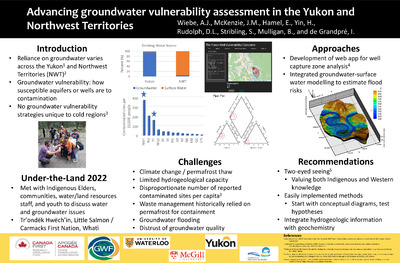| dc.contributor.author | Wiebe, A.J. | |
| dc.contributor.author | McKenzie, J.M. | |
| dc.contributor.author | Hamel, E. | |
| dc.contributor.author | Yin, H. | |
| dc.contributor.author | Rudolph, D.L. | |
| dc.contributor.author | Stribling, S. | |
| dc.contributor.author | Mulligan, B. | |
| dc.contributor.author | de Grandpré, I. | |
| dc.date.accessioned | 2023-06-15 19:03:27 (GMT) | |
| dc.date.available | 2023-06-15 19:03:27 (GMT) | |
| dc.date.issued | 2023-05-15 | |
| dc.identifier.uri | http://hdl.handle.net/10012/19541 | |
| dc.description | This research was undertaken, thanks, in part, to support from the Global Water Futures Program funded by the Canada First Research Excellence Fund (CFREF). | en |
| dc.description.abstract | Reliance on groundwater for drinking water supplies varies across the Yukon and Northwest Territories (NWT), with usage of up to 97% in Yukon and 5% in NWT. Groundwater vulnerability assessments, which review water quality concerns such as the susceptibility for aquifers or wells to become contaminated in a specified area, have been developed in southern regions and their applicability within cold regions is uncertain. The approach of the present study was to learn from Indigenous Elders and community members about local water concerns in several communities, to develop tools for assessing groundwater vulnerability, and to recommend strategies for assessing northern groundwater vulnerability. Challenges such as climate change and permafrost thaw were reviewed, as well as contaminated sites records across the Yukon and NWT. A web app was developed for visualizing theoretical well capture zones for aquifers with simplified geometry that are bounded by surface water features. A fully integrated surface water – groundwater model was also developed for one community to assess well vulnerability to increasing summer peaks flows in the Yukon River. Two-dimensional modelling of permafrost thaw has been conducted to explore the dynamics of solute transport in supra- and subpermafrost aquifer regions, which could assist with understanding releases from waste disposal sites such as landfills that historically relied on permafrost for waste containment. Recommendations include valuing both Indigenous and Western knowledge perspectives, starting with the development of “groundwater intuition” and easily implemented methods and developing ways to test hypotheses, and integrating hydrogeologic information with geochemistry. | en |
| dc.description.sponsorship | CFREF Global Water Futures, New Tools for Northern Groundwater Vulnerability Assessment || CFREF Global Water Futures, Core Modelling Team | en |
| dc.language.iso | en | en |
| dc.publisher | University of Waterloo | en |
| dc.relation.ispartofseries | Global Water Futures; | |
| dc.rights | Attribution-NoDerivatives 4.0 International | * |
| dc.rights.uri | http://creativecommons.org/licenses/by-nd/4.0/ | * |
| dc.subject | groundwater | en |
| dc.subject | vulnerability assessment | en |
| dc.subject | cold regions | en |
| dc.subject | source water protection | en |
| dc.subject | GWF ASOM 2023 | en |
| dc.title | Advancing groundwater vulnerability assessment in the Yukon and Northwest Territories | en |
| dc.type | Conference Poster | en |
| dcterms.bibliographicCitation | Wiebe, A.J., McKenzie, J.M., Hamel, E., Yin, H., Rudolph, D.L., Stribling, S., Mulligan, B., and de Grandpré, I. (2023). Advancing groundwater vulnerability assessment in the Yukon and Northwest Territories. Global Water Futures Annual Open Science Meeting 2023; Saskatoon, SK, Canada, 15-17 May 2023. | en |
| uws.contributor.affiliation1 | Faculty of Science | en |
| uws.contributor.affiliation2 | Earth and Environmental Sciences | en |
| uws.typeOfResource | Text | en |
| uws.peerReviewStatus | Unreviewed | en |
| uws.scholarLevel | Post-Doctorate | en |


